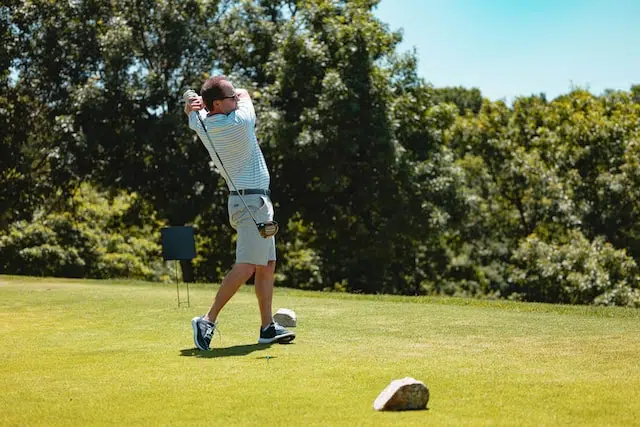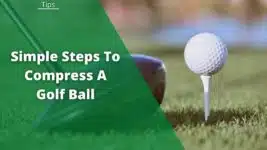Contents
- Why Is Swing Speed Important?
- A Step-by-Step Guide on How To Increase Swing Speed
- 1. Improve Your Strength and Fitness By Hitting The Gym
- 2. Focus On Strengthening Your Core
- 3. Improve Your Flexibility
- 4. Monitor Your Progress With A Golf Launch Monitor
- 5. Use a Shaft That Works for You
- 6. Reduce Tension in Your Pre-Swing Routine
- 7. Check If You Need to Alter Your Grip
- 8. Build Resistance in Your Lower Body to Help the Backswing
- 9. Initiate Your Downswing With Your Lower Body, Not Your Upper Body
- 10. Use A Swing Speed Training Aid
- 11. Get a Longer or Better Speed-focused Club
- 12. Get Coached With Some Lessons
- Exercises to Increase Clubhead Speed
- Training Aids to Increase Clubhead Speed
- Final Thoughts
- FAQs
While it would be unlikely for everyone to undergo the exact same transformation, that doesn’t mean you can’t increase your swing speed and reap some benefits.
Here are 12 steps for how to increase your clubhead speed:
- Increase your strength
- Strengthen your core
- Improve your flexibility
- Monitor your progress
- Find the right shaft
- Build a pre-shot routine
- Assess your grip
- Fix your backswing
- Initiate your downswing with your lower body
- Training aids like SuperSpeed Golf training system
- Use a longer or more speed-focus club
- Try golfing lessons
Getting faster swing speeds requires tweaking several specific parts of your swing fundamentals, and it will take some dedicated practice.
Read on for a step-by-step approach to increasing your clubhead speed in golf, including drills, exercises, and equipment that can help you make significant progress.
Why Is Swing Speed Important?
A faster golf swing enables you to get more power and, therefore, distance on your shot.
Research has found that for every 1 mile-per-hour increase in your clubhead speed, you will gain 3 yards of distance.
So if you can add ~3 miles per hour, that’s another 10 yards with each stroke. Some dedicated practitioners could gain as much as 10 mph, leading to some serious extra yardage.
It is especially vital during your drive at the start of the hole as this has the most potential for getting distance and saves you from potentially adding another unnecessary shot to the scorecard for the hole.
A Step-by-Step Guide on How To Increase Swing Speed
To start your training regimen of getting faster swing speeds, we have laid out an approach that can help you focus on the particular areas that will help you increase. Some may be obvious and just require consistent practice, while others may not be so obvious.
1. Improve Your Strength and Fitness By Hitting The Gym
Unfortunately, not all golfers are in the best shape of their lives. Some extremely good golfers, for example, are overweight but have learned to perform within their limitations.
Professional golfers spend a lot of time in the gym and not just for the good physique that it builds. They understand the functions of each body part and muscle combination and target these areas with specific exercises.
For the best results, it would be highly recommended to address specific areas to increase your clubhead speed.
The cables can be a golfer’s best friend in the gym. You can replicate parts of a swing with them and build strength. Integrate the bent-over lateral raise, cable chops with a step, and a single-arm rotation press with a step into your workouts.
This video shows you what to do very well:
2. Focus On Strengthening Your Core
The swing rotates around your core, and the more strength you have in your core muscles, the more clubhead speed you will be able to generate. Stability and balance are key in a good swing, and you can improve both by exercising your core muscles.
Your core muscles are composed of a group of muscles in the body’s center. This consists mainly of the abdominal muscles, glutes, lower back, and sides of the hips.
To activate your core, you have to strengthen and stretch these muscles.
Give the torso stretch a go. To do this:
- Stand up straight, facing away from your wall.
- Turn to the left, placing your right hand on the wall, and push your torso around.
- Return to the center and swap sides holding for 45 seconds in each direction.
- Repeat this twice.
Increasing the range of motion around your torso will allow you to build up more torque to rotate your torso faster in your golf swing.
Additionally, you can try the Russian twist too.
- Place your bottom on the ground and lift up your legs slightly.
- Lean back a little and spent 30 seconds twisting from side to side with a ball if you have one.
- If not, you can use an imaginary ball and it still works well.
- Repeat this 3 times.
- You could also just hold your hands together and do it without a ball just focus on the twisting motion.
The stretches will add between 20 and 30 degrees to your range of motion and make it stronger. To further improve your core strength, take a look at deadlifts. The form is more important than the weight you are lifting. Bringing a few sets of deadlifts regularly into your gym routine will help you have a strong, injury-resistant back.
3. Improve Your Flexibility
Being flexible will enable you to optimize your turn in the backswing to create the largest arc and distance for the golf club to travel. Most top golfers can turn their shoulders 90 degrees or more enabling their backs to face the target at the top end of their swing.
Try the standing forward bend stretch, the chest stretch, and the shoulder stretch to be more flexible.
4. Monitor Your Progress With A Golf Launch Monitor
All your gym sessions, training, and speed build-up are in vain if you cannot track whether it affects your clubhead speed.
After making progress checks on your strength and flexibility, it is highly recommended that you acquire a golf launch monitor that can report back on your speed and other components of your swing.
Technology has improved so much that they even have budget launch monitors for you to choose from.
Alternatively, you could use a high-speed camera in place of a monitor.
Recording your swing will provide you with visual feedback highlighting areas where you can improve and identify any faults that must be corrected. The swing can take less than a second to complete.
5. Use a Shaft That Works for You
If you have a too heavy shaft, this will hinder your progress with swing speed as half of your battle is spent maneuvering the club and not focusing on the swing itself. Make sure the shaft weight is light enough to comfortably operate for you but not too light so it would be unable to help create the power desired. For example, using a graphite shaft instead of a steel shaft will mean your shaft is lighter and you could create a faster swing speed, allowing for more power.
6. Reduce Tension in Your Pre-Swing Routine
Tension in the swing leads to a loss in swing and clubhead speed resulting in unpredictable results.
To minimize the tension, you can take some actions before and during the swing.
Building a pre-shot routine that you follow on every shot. Most professional golfers have a pre-shot routine where they take a few practice shots and some deep breaths to calm them down. This is when you can visualize your shot shape and where you want it to land.
Here are some suggestions for building your pre-shot routine:
- Before lining up your shot, take some deep breaths. The deep breaths will calm you down and enable you to focus more clearly on the task at hand.
- Perform a few arm waggles. When addressing the ball, take a few waggles to free up any tension still left in your arms.
- Check your grip pressure. Having a fluid swing will aid you in getting the highest clubhead speed. Ensure that your grip pressure on the club is not too tight, as this will restrict the swing flow.
- Execute your shot confidently. Avoid standing over your golf ball for too long, as this will allow doubts and tension to creep back into your mind.
There are a lot of variations in professional golfers’ pre-shot routines, though, so keep working to optimize yours.
7. Check If You Need to Alter Your Grip
It goes without saying: don’t grip the golf club too lightly or too gently, as both lead to an adverse swing attempt. If you haven’t already, try to obtain a neutral grip before your next shot. You can do this by laying the grip in the palm of your fingers, placing your left thumb right of center for the ideal neutral grip.
8. Build Resistance in Your Lower Body to Help the Backswing
Begin your backswing by building resistance in your lower body and turning around the trailing leg. At this stage, your weight should be slightly more towards your back leg and your trailing foot pushed into the ground. This will create the torque that you will require for the downswing.
Extend your arms to push the clubhead as far as possible away from your head.
Create lag by cocking your wrists, thus enhancing the distance that the club head has to travel back to the impact area.
Extending your arms and creating lag creates a wide arc that will enable you to have a long distance from the top of your backswing to the point of impact.
Swing back as far as possible without creating stress on your upper body. You can lift your leading heel slightly to achieve more distance in the backswing.
Some golfers bend their leading elbows to generate maximum turn, although this is not advisable for golfers that do not have absolute control over their swing dynamics.
Read more: How To Optimize Your Right Arm & Elbow To Improve Your Golf Swing
9. Initiate Your Downswing With Your Lower Body, Not Your Upper Body
You should initiate your downswing with your lower body and not with your arms or upper body for maximum power and speed.
For the ultimate weight transfer to your leading leg, you should push off your trailing foot and extend your leading hips upwards. Rotate around your core and avoid swaying your hips too far forward.
Create lag by keeping your wrists cocked, pulling the grip towards your leading side, and then upwards. See the video for more detail.
Maximum speed should be a point of impact and not during your downswing. To avoid casting the club during your backswing, you must keep your wrists cocked until the last possible moment.
Casting will create a swoosh sound midway between the top of your backswing and the impact area. This will cause a loss of speed at impact.
Keeping the lag and releasing just prior to impact will produce a swoosh sound at or just after impact. This is where maximum clubhead speed is required to produce the optimum speed and distance.
For maximum distance, you have to follow through and release the club after impact to prevent a loss of speed.
These tips will get you started on how to generate more clubhead speed.
10. Use A Swing Speed Training Aid
If you are struggling with the above steps on your own, one effective way to increase clubhead speed and swing speed, and determine where you create the most speed is by using a training aid like the SuperSpeed Golf training system.
Firstly, develop your fast-twitching muscles by following the Overspeed training system. Start by swinging a light object, such as an alignment stick or the grip of your driver, as fast and as aggressively as you can. At the end of your swing, take a pause and then swing the club back to your trailing side as fast as possible to retain symmetry.
Secondly, develop your hand, forearm, and slow-twitch muscles by fast swinging a heavier object. A school of thought thinks that although heavy objects will strengthen the muscles mentioned, a heavy object will slow down your swing.
Lastly, execute a few practice swings at your top speed with your driver
The tempo of your swing will play a significant role in delivering the clubhead at maximum speed without pulling you off balance.
11. Get a Longer or Better Speed-focused Club
Your club might not be for you and if you have tried all of the above steps and you are seeing little change with your current club, a change might be needed. To make your golf swing one with increased clubhead speed, if you were to get a longer club or make it longer, this might lessen your control over the club and the direction it heads in, but it is almost sure to increase clubhead speed and distance.
Additionally, some drivers now focus on providing a faster swing instead of a slower swing speed. For example, this Mizuno ST-Z 220 Driver is dubbed as one of the best clubs to increase ball speeds. It is a hefty investment, but it could be for you if you are committed to increasing golf swing speed.
12. Get Coached With Some Lessons
There is a lot you can learn in golf, but sometimes you just need external feedback to help you improve. You could have the best club, the ideal grip, and the best training aids around, but there is always the chance that if you are still struggling with your swing after taking many tips into account, you need someone else to identify that issue.
Once the issue or bad habit is identified and rectified over time, you can move forward with your club head speed practice to increase the speed you can create on your shots.
Exercises to Increase Clubhead Speed
There are several drills to increase clubhead speed as a golfer:
-
Turn the Club Upside Down
Flip your club upside down and swing as you would with a grip by the driver’s head to encourage you to swing faster. It can be best to do this in a baseball-style shot. Focus on creating a very fast swing, and it will be easier with the lighter object. At the end of your swing, pause, then swing the club back to your trailing side as fast as possible to retain symmetry. The speed will be drilled into you, and when you flip the club around it should be easier to associate yourself with impressive swing speed.
-
The Slap Drill
This doesn’t require any equipment and you can be anywhere. Simply place your lead palm in front of you, settle in a stance for a drive, and pretend you are gripping a club with your other hand. Turn so your gripping hand is behind you and your leading palm is pointing to where the ball would be. Then, turn, strike through and with the gripping hand, try and slap the leading hand like you would have connected with the ball. There is a weight and energy transfer in the drill too.
-
Get Down to the Driving Range and Create a Speed Reserve
By smashing 50 balls a few times per week at the driving range you are practicing at the highest speeds and clubhead speeds you can create. Raising that ceiling will increase the average swing speed to be able to hit the ball at that speed more regularly.
Training Aids to Increase Clubhead Speed
Use a Launch Monitor
The launch monitor is one of the best training aids you can have. It will provide feedback on a variety of data related to your golf swing and the trajectory of the club, as well as the reaction of the golf ball after impact. This can help you understand where you may be going wrong with your swing and how to improve it.
The device will provide data on the ball, such as ball speed, smash factor, launch angle, and launch direction, and for the club, it will tell you your club speed, attack angle, and much more.
Look at a Swing Analyzer
If you are more of a visual learner than someone who is data-focused, a swing analyzer could be for you if you want to know how to get more clubhead speed. Take the Zepp Golf 3D swing analyzer as an example. It lets you replay and review your swing in 360° from any angle. You can record and analyze your swing in HD video and compare your swing directly to PGA Tour Pros in 3D and video.
Final Thoughts
Most golfers continually search for a few extra miles per hour clubhead speed and ball speed for an extra few yards.
One of the key ways for how to increase clubhead speed is by building muscle. This has proven through the years to be an effective way to achieve more clubhead speed. First, Tiger Woods improved his game by building muscle, followed by Rory McIlroy, and the finest example is the recent changes that Bryson DeChambeau has undergone.
That is not the only way DeChambeau has helped raise his clubhead speed.
Only building your body in isolation will not provide the desired results. Your mental attitude and swing should get equal attention and research.
Finally, once you have worked on all the required areas it is highly advisable that you track your progress and identify areas that can be improved to achieve the extra miles per hour and the distance you want.
Push the limits of speed and distance for the most enjoyment possible.
FAQs
What Is a Good Clubhead Speed?
If your clubhead speed is 125 mph, you would be in the top 10% of players. The average PGA tour player is around 114mph. While 93.4 mph is the average male golfer’s speed, with 45% between 91 and 100mph.
Does Strength Increase Clubhead Speed?
Strength definitely does increase clubhead speed. The more muscle mass you have behind your swing, the harder you can hit it. Though, if a player gains too much strength and therefore loses some flexibility, this can harm the clubhead speed negatively. However, you can increase your swing speed by perfecting the rotation of your upper body too.
Will a Lighter Shaft Increase Clubhead Speed?
A lighter shaft usually increases clubhead speed. A lighter shaft enables you to focus on the connection between the clubhead and the ball rather than the weight of the shaft. However, you don’t want it too light so that it would be unable to help create the power you wish for.
Nick is the founder of GolfSpan and an avid golfer. He's not quite a pro but has over 15 years of experience playing and coaching golfers worldwide. His mission is to bring the golfing community a better experience when it comes to choosing the right golf gear and finding the right setup for your game.








